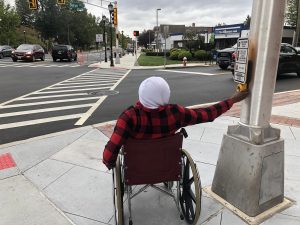 Everyone has a right to travel safely, regardless of age, ability, or fitness level. The most vulnerable pedestrian populations include both the young and the elderly.Both groups tend to have lower physical capabilities when compared to the average pedestrian, tending to walk at a slower rate and have decreased peripheral vision. As the average age of Americans continues to rise, it is important to incorporate the needs of roadway users of every age into design. Following the simple but powerful idea from 8 80 Cities that states, “if everything we do in our cities is great for an 8-year-old and an 80-year-old, then it will be better for all people,” one of the best places to start for producing a safer walking environment for both children and seniors is by improving street crossings.
Everyone has a right to travel safely, regardless of age, ability, or fitness level. The most vulnerable pedestrian populations include both the young and the elderly.Both groups tend to have lower physical capabilities when compared to the average pedestrian, tending to walk at a slower rate and have decreased peripheral vision. As the average age of Americans continues to rise, it is important to incorporate the needs of roadway users of every age into design. Following the simple but powerful idea from 8 80 Cities that states, “if everything we do in our cities is great for an 8-year-old and an 80-year-old, then it will be better for all people,” one of the best places to start for producing a safer walking environment for both children and seniors is by improving street crossings.
Crosswalk Markings
Crosswalks are a great way to improve roadway pedestrian safety, but not all crosswalks are created equal. Some crossing improvements require shortening the distance of the crosswalk, while others are more focused on lengthening the amount of time given to pedestrians for crossing. Essentially, crossing enhancements should make it easier for pedestrians of any and all abilities to cross the road safely. Large, costly infrastructure projects are not always required for this; there are a variety of affordable and low-effort methods to improve crosswalk safety. Easy enhancements include high-visibility crosswalks and pavement markings that can help assist and encourage users to cross in the safest location while also making them more visible. High-visibility crosswalks use brighter paint and patterns, including ladder, zebra, and continental crosswalk markings that are more visible to drivers, pedestrians, and all roadway users from farther distances as compared to the more standard parallel lines. Adding this enhancement is simple; only street paint is necessary to create these markings. Additionally, in-street signage, such as “STOP Here for Pedestrians” or “YIELD Here to Pedestrians” and the use of materials such as inlay or thermoplastic tape, instead of paint, can help increase the visibility of crosswalk markings.
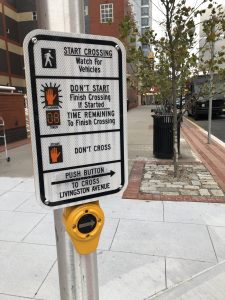 Enhanced Signals
Enhanced Signals
Enhanced pedestrian signals can benefit people of all ages. Countdown pedestrian signals consist of a regular pedestrian signal with standard shapes and colors as well as an added display showing the number of seconds left to cross the street before the signal changes. Users of all age groups easily understand these countdown signals and can help pedestrians to make a more informed decision as to whether they have enough time to cross safely. While this visual cue is extremely helpful, audible enhancements can help improve safety by informing visually impaired individuals about when it is safe to cross. Accessible pedestrian signals communicate information about the “walk” and “don’t walk” intervals at signalized intersections in non-visual formats, including audible tones and vibrotactile surfaces, to pedestrians who are blind or have low vision. These signals can provide information including the beginning of the walk interval, the direction of the crosswalk, the location of the destination curb, and intersection street names. Like countdown signals, accessible pedestrian signals can help to keep pedestrians of all ages safer by allowing for more accurate judgments of when to start a crossing, and reductions in crossings begin during the don’t walk phase.
Long pedestrian crossings without enough time to cross are especially problematic for seniors and young pedestrians who tend to move slower when crossing the street. If children or senior pedestrians who no longer drive cannot cross multi-lane roads or other long crossings, they are effectively trapped in their neighborhoods, unable to walk to school, stores, or other parts of their community.
There are a few quick and relatively inexpensive ways to increase safety for vulnerable pedestrians using time-based solutions. One method is leading pedestrian intervals (LPI). Leading pedestrian intervals (LPI) are crosswalks that allow pedestrians to cross the street for 3 to 7 seconds before the light turns green for vehicles, essentially giving them a head start. Another simple method is updating signal timing, increasing the number of seconds the pedestrian has to cross a crosswalk. Making these changes can also prove to be incredibly simple, often with only a technical alteration required if the road is locally controlled.
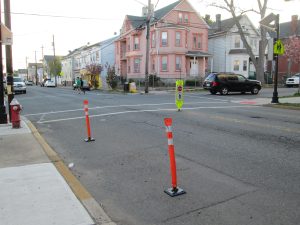 Crosswalk Enhancements
Crosswalk Enhancements
These following design elements require physical changes, which can often be costlier and require more time to complete. “Daylighting” is when curb-side space within 20 to 30 feet of an intersection is permanently blocked using bollards or paint to ensure that the space can’t be used for vehicle parking. This increases visibility for both pedestrians and motorists and helps to reduce conflicts. This can be especially helpful in improving sight distance and can help to shorten crossings by allocating less road space to vehicles near crossings. Another technique to increase visibility and shorten crossings are curb extensions, also known as a “bump-outs.” Curb extensions visually and physically narrow the roadway, creating safer and shorter pedestrian crossings while increasing the available space for street furniture, benches, plantings, and street trees. Curb extensions increase the overall visibility of pedestrians by aligning them with the parking lane and reducing the crossing distance for pedestrians. Curb extensions can be permanently implemented with cement, but they can also be implemented using paint and bollards. The cost and timeframe for implementation of a curb extension project can vary depending on which methods and materials are being used.
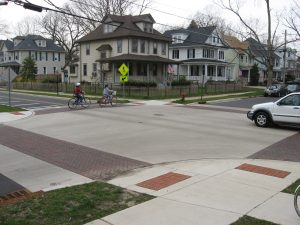 Engineering Improvements
Engineering Improvements
The next two design methods, raised crosswalks and pedestrian refuge islands, are larger infrastructure projects which are very effective but often take longer to get approved. Raised crosswalks are pedestrian crossings where the pavement is elevated above street level, and the crosswalk is flush with the height of the sidewalk. They can provide a stable way for individuals of all ages to cross the street, especially those with visibility and auditory difficulties. They also act as a speed-reducing traffic calming measure, forcing drivers to slow down at these crossings. They also improve drivers’ awareness of a pedestrian crossing, particularly at mid-block crossing locations. Raised intersections take this concept a step further, raising the entire intersection to the level of the sidewalk. Raised intersections have similar benefits to raised crosswalks and can be especially helpful in areas where enhancing pedestrian movement is a major goal, such as transit stops or commercial areas.
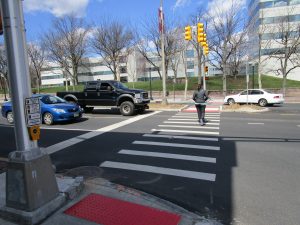 Pedestrian refuge islands are another physical improvement that can shorten crossings and increase pedestrian safety. A pedestrian refuge island is a median with a refuge area that is intended to help protect pedestrians who are crossing a multi-lane road, allowing pedestrians to focus on one direction of traffic at a time as they cross and giving them a place to wait for an adequate gap in oncoming traffic before finishing the crossing. Pedestrian refuge islands enhance pedestrian safety and accessibility by reducing crossing distances and also help to calm traffic by narrowing the roadway.
Pedestrian refuge islands are another physical improvement that can shorten crossings and increase pedestrian safety. A pedestrian refuge island is a median with a refuge area that is intended to help protect pedestrians who are crossing a multi-lane road, allowing pedestrians to focus on one direction of traffic at a time as they cross and giving them a place to wait for an adequate gap in oncoming traffic before finishing the crossing. Pedestrian refuge islands enhance pedestrian safety and accessibility by reducing crossing distances and also help to calm traffic by narrowing the roadway.
Walking Environment Improvements
Other enhancements and improvements to the walking environment, such as wide sidewalks, increased shade, seating, and pedestrian scale lighting, can also help to improve conditions and encourage increased walking among both students and seniors. The width of a sidewalk should be determined primarily by the expected volume of pedestrian traffic. In high-traffic areas, wider sidewalks are necessary. According to the Federal Highway Administration’s (FHWA) Recommended Guidelines for Sidewalks and Walkways, a minimum width of five feet is required to allow two adults to walk comfortably side by side. Sidewalks in areas with significant pedestrian activity, such as near parks, schools, and major destinations, should be eight to ten feet wide (NJ School Zone Design Guide).
Shade plays a crucial role in making sidewalks more inviting and usable, especially during the hottest parts of the day. Sidewalks absorb and radiate heat, which can make walking uncomfortable. Street trees provide shade that reduces this heat effect and cools the sidewalk, making the environment more pleasant for pedestrians. Additionally, walking in the shade versus the sun can significantly impact perceived temperature due to reduced solar radiation. Trees also serve as a physical barrier between pedestrians and traffic, offering protection by likely stopping a vehicle before it reaches someone walking. Moreover, trees near the street can slow down drivers, as drivers tend to be aware that in a collision with a tree, the tree generally wins.
For children, older adults, and individuals with disabilities, nighttime walking can be particularly challenging. Effective pedestrian lighting is essential for their safety and convenience after dark. Proper street lighting enhances visibility and personal security and should be implemented in high-traffic areas and along school routes. Good lighting at intersections and pedestrian crossings is especially important to ensure safe passage where different modes of transportation intersect.
The age friendly walkability improvements described above are not only good for children and seniors, they benefit people of all ages. By prioritizing improved crossings, wider sidewalks, seating, and pedestrian scale lighting, communities create vibrant, inclusive spaces that encourage walking, foster social interactions, and promote healthier lifestyles. These thoughtful design choices lead to safer environments, reduced traffic congestion, and increased economic activity, ultimately benefiting everyone in the community. Advocating for age-friendly initiatives paves the way for a future where mobility is accessible and enjoyable for people of all ages and abilities, making our communities more livable, welcoming, and connected.
